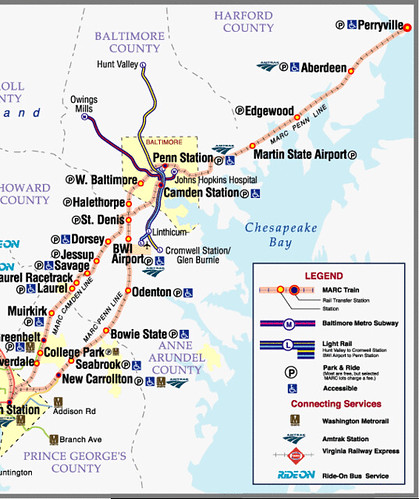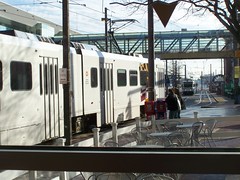I offer a dumb idea
There are lots of proposals to extend the WMATA subway system. These proposals are driven by land development objectives and a failure to consider the development of a truly integrated transit system employing multiple modes best chosen to meet demands in a manner that is respectful of available resources.
Mostly, the land development interests want to make their projects more attractive to the Washington market, as the Baltimore Sun said yesterday about Frederick--making it a bedroom community of DC.
From that standpoint, extending the WMATA subway seems to be a no brainer. People know what it is and what it does. So it's easy to understand.
But it doesn't make sense to extend the system significantly beyond its current boundaries--note I say beyond the current boundaries--not whether or not to intensify subway service within the metropolitan service area.
That's because after a certain distance, heavy rail makes less sense and railroads (really really heavy rail) make more sense. This is a point that BeyondDC has been making for years, and his basic idea has been amplified in some of my past blog entries such as "Regional transportation planning and fixed rail service."
The distance between DC and Baltimore is 45 miles. The distance between the end of the DC fixed rail transit system (Greenbelt) and the end of the Baltimore light rail system (BWI Airport) is about 29 miles.

MARC commuter railroad map showing service between the Baltimore region and DC.
These distances should be covered by railroads, not subway systems.
In writing about transit networks, I distinguish between 3 types when it comes to metropolitan and regional transit:
- Regional -- multi-state connections -- for the most part these don't exist for transit, but do for freight railroad, airplane travel, and the Interstate highway system. The Northeast Corridor railroad passenger service offered by Amtrak is an example of such a transit network.
- Metropolitan -- transit systems like the WMATA subway and bus system, the combined railroad, subway, bus, and waterborne transit services in the NYC or Boston regions.
- Sub-metropolitan transit systems (in the DC region, locally provided services such as RideOn in Montgomery County Maryland or the Downtown Circulator in DC are examples of services within the subnetwork category of the Metropolitan Transit Network).
For a delineation of the metropolitan transit network and the constituent subnetworks, see "Thinking about the transit network."
Even though the Census counts the DC and Baltimore regions as one, they aren't one region when it comes to trip behavior. The Baltimore region needs to do its own thing, as does the DC region. And DC should not let its transportation priorities be directed by exurban interests.
But here's my stupid idea. (It's a burden to only write 100% correct, intelligent blog entries.)
If it is so important to improve the connections between suburban Baltimore, in particular Fort Meade and BWI Airport, and DC, and you don't want to use the extant transit resources most intelligently and most expeditiously by expanding and extending the MARC railroad service, rather than wasting resources extending the WMATA subway system, instead extend the clunky Baltimore light rail system to Greenbelt.
Don't divert the attention of the DC metropolitan transit network (the subway system), which needs to focus on serious issues of its own, to solve the real estate and other interests of Greater Baltimore.

Baltimore Light rail through the windows of California Tortilla, near the Baltimore Convention Center.
Labels: fixed rail transit service, Growth Machine, railroads, sustainable land use and resource planning, transportation planning



0 Comments:
Post a Comment
<< Home